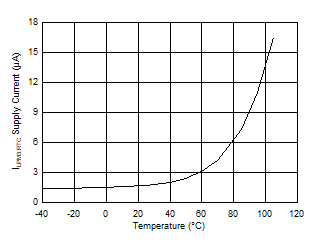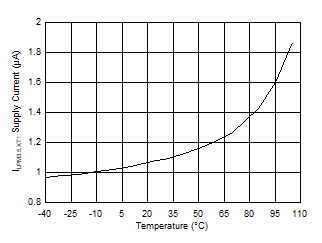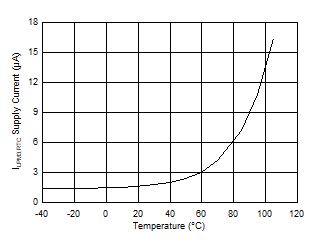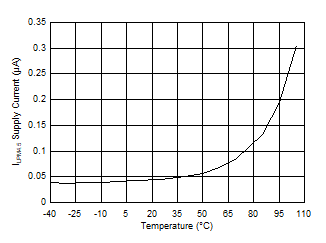ZHCSJG5C March 2019 – September 2021 MSP430FR2475 , MSP430FR2476
PRODUCTION DATA
- 1 特性
- 2 应用
- 3 说明
- 4 功能模块图
- 5 Revision History
- 6 Device Comparison
- 7 Terminal Configuration and Functions
-
8 Specifications
- 8.1 Absolute Maximum Ratings
- 8.2 ESD Ratings
- 8.3 Recommended Operating Conditions
- 8.4 Active Mode Supply Current Into VCC Excluding External Current
- 8.5 Active Mode Supply Current Per MHz
- 8.6 Low-Power Mode LPM0 Supply Currents Into VCC Excluding External Current
- 8.7 Low-Power Mode (LPM3, LPM4) Supply Currents (Into VCC) Excluding External Current
- 8.8 Low-Power Mode LPMx.5 Supply Currents (Into VCC) Excluding External Current
- 8.9 Typical Characteristics – Low-Power Mode Supply Currents
- 8.10 Current Consumption Per Module
- 8.11 Thermal Resistance Characteristics
- 8.12 Timing and Switching Characteristics
-
9 Detailed Description
- 9.1 Overview
- 9.2 CPU
- 9.3 Operating Modes
- 9.4 Interrupt Vector Addresses
- 9.5 Bootloader (BSL)
- 9.6 JTAG Standard Interface
- 9.7 Spy-Bi-Wire Interface (SBW)
- 9.8 FRAM
- 9.9 Memory Protection
- 9.10
Peripherals
- 9.10.1 Power-Management Module (PMM)
- 9.10.2 Clock System (CS) and Clock Distribution
- 9.10.3 General-Purpose Input/Output Port (I/O)
- 9.10.4 Watchdog Timer (WDT)
- 9.10.5 System (SYS) Module
- 9.10.6 Cyclic Redundancy Check (CRC)
- 9.10.7 Enhanced Universal Serial Communication Interface (eUSCI_A0, eUSCI_B0)
- 9.10.8 Timers (TA0, TA1, TA2, TA3 and TB0)
- 9.10.9 Hardware Multiplier (MPY)
- 9.10.10 Backup Memory (BAKMEM)
- 9.10.11 Real-Time Clock (RTC)
- 9.10.12 12-Bit Analog-to-Digital Converter (ADC)
- 9.10.13 eCOMP0
- 9.10.14 Embedded Emulation Module (EEM)
- 9.11
Input/Output Diagrams
- 9.11.1 Port P1 (P1.0 to P1.7) Input/Output With Schmitt Trigger
- 9.11.2 Port P2 (P2.0 to P2.7) Input/Output With Schmitt Trigger
- 9.11.3 Port P3 (P3.0 to P3.7) Input/Output With Schmitt Trigger
- 9.11.4 Port P4 (P4.0 to P4.7) Input/Output With Schmitt Trigger
- 9.11.5 Port P5 (P5.0 to P5.7) Input/Output With Schmitt Trigger
- 9.11.6 Port P6 (P6.0 to P6.2) Input/Output With Schmitt Trigger
- 9.12 Device Descriptors
- 9.13 Memory
- 9.14 Identification
- 10Applications, Implementation, and Layout
- 11Device and Documentation Support
- 12Mechanical, Packaging, and Orderable Information
封装选项
机械数据 (封装 | 引脚)
散热焊盘机械数据 (封装 | 引脚)
订购信息
8.9 Typical Characteristics – Low-Power Mode Supply Currents

| VCC = 3 V | RTC enabled | SVS disabled |

| VCC = 3 V | XT1 enabled | SVS enabled |

| VCC = 2 V | RTC enabled | SVS disabled |

| VCC = 3 V | SVS disabled |